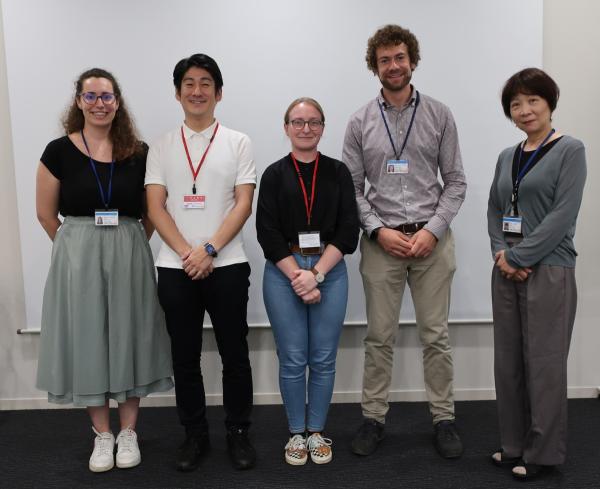On August 30, 2024, Associate Professor Tetsuhide Shimizu (Tokyo Metropolitan University) gave a lecture at NIMS as the 161st seminar on structural materials. Postdoctoral Researcher Caroline Hain, Postdoctoral Researcher (Empa), who also visited NIMS, gave a lecture on her latest research.
Speaker:
Associate Professor Tetsuhide Shimizu (Tokyo Metropolitan University) /Google Scholar | Tetsuhide Shimizu
Caroline Hain Postdoctoral Researcher (Empa)
Organizer: Thomas Edward James Edwards (Mechanical Properties Group)
 Photo after the seminar:
Photo after the seminar:
Associate Professor Tetsuhide Shimizu (second from left) and Postdoctoral Researcher Caroline Hain (center)
High Power Impulse Magnetron Sputtering (HiPIMS) has been focused on as a next-generation Ionization Physical Vapor Deposition (I-PVD) technology. It has been actively studied since early 2000s, and in recent years the uniqueness of this technolgy is again attracting attention as a new manufacturing process in line with the recent growth of the semiconductor industry. In this presentation, the characteristics of HiPIMS technology will be briefly introduced, and its uniqueness among the other I-PVD process will be reviewed from the viewpoint of flexibility of process control based on the transient phenomena of HiPIMS plasma.
Biography:
Tetsuhide Shimizu is an associate professor of Faculty of Systems Design, Tokyo Metropolitan University, Tokyo, Japan since April 2020. He is also a visiting scientist at Department of Physics, Chemistry and Biology, Linköping University in Sweden since 2015. His main field of interest is surface engineering of transition metal nitride and oxide coatings, focusing on low temperature growth by high power impulse magnetron sputtering (HiPIMS). In particular, HiPIMS process design based on the understanding of time-transient plasma physics using several plasma diagnostics tools, e.g., time resolved OES and mass-spectrometry studies are in focus. Recently the process development is further extended also for synthesis of metal nano-particles by using hollow cathode sputtering.